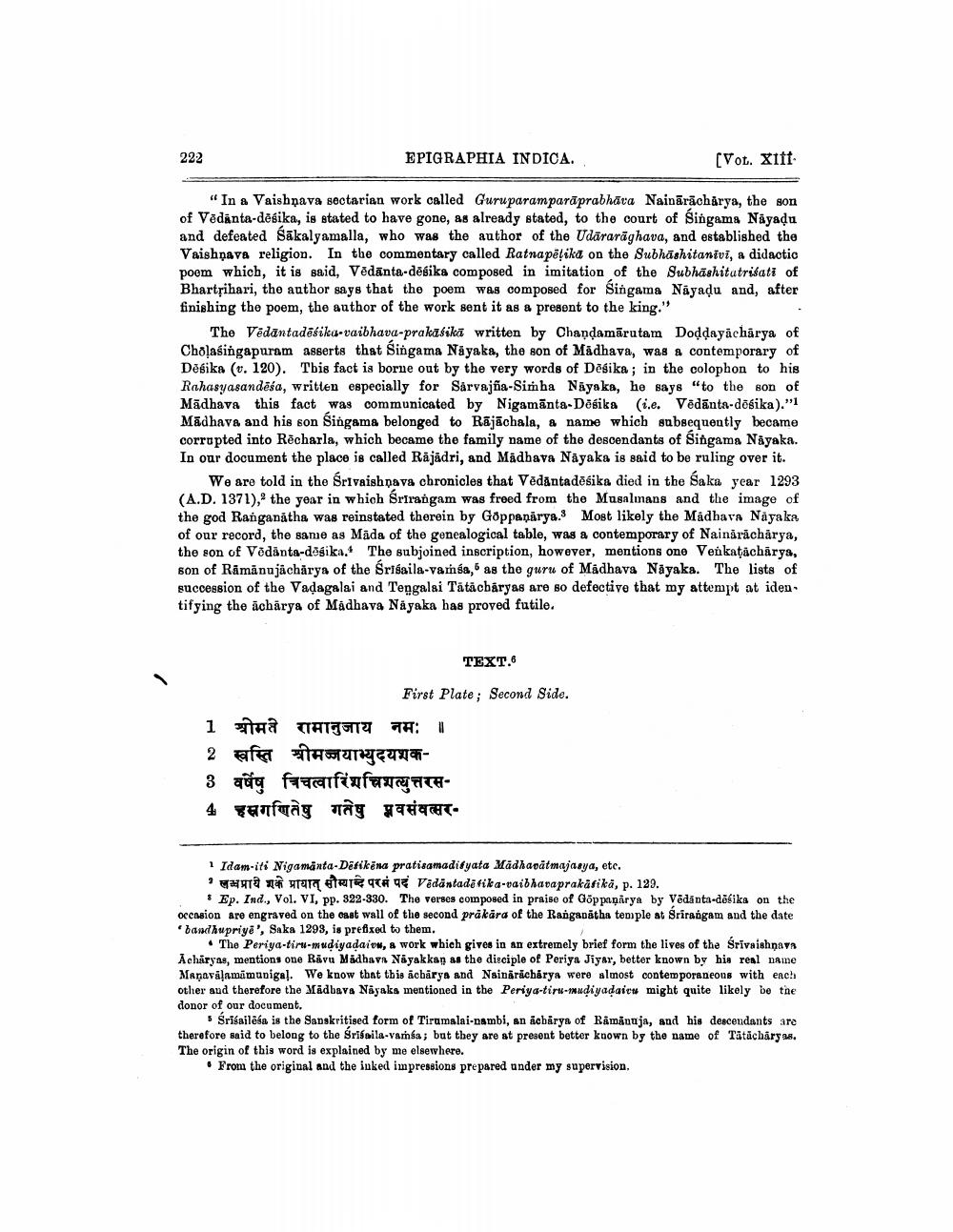________________
222
EPIGRAPHIA INDICA.
[VOL. XIII
"In a Vaishnava sectarian work called Guruparamparaprabhava Nainaracharya, the son of Vedanta-dēsika, is stated to have gone, as already stated, to the court of Singama Nayaḍu and defeated Sakalyamalla, who was the author of the Udararaghava, and established the Vaishnava religion. In the commentary called Ratnapētika on the Subhashitanivi, a didactic poem which, it is said, Vedanta-desika composed in imitation of the Subhashitatrisati of Bhartrihari, the author says that the poem was composed for Singama Nayaḍu and, after finishing the poem, the author of the work sent it as a present to the king."
The Vedantadesika-vaibhava-prakasika written by Chandamarutam Dodḍayacharya of Cholasingapuram asserts that Singama Nayaka, the son of Madhava, was a contemporary of Děsika (v. 120). This fact is borne out by the very words of Desika; in the colophon to his Rahasyasandesa, written especially for Sarvajña-Simha Nayaka, he says "to the son of Madhava this fact was communicated by Nigamanta-Desika (i.e. Vedanta-dēsika)."1 Madhava and his son Singama belonged to Rajachala, a name which subsequently became corrupted into Recharla, which became the family name of the descendants of Singama Nayaka. In our document the place is called Räjädri, and Madhava Nayaka is said to be ruling over it.
We are told in the Srivaishnava chronicles that Vedantadēsika died in the Saka year 1293 (A.D. 1371), the year in which Srirangam was freed from the Musalmans and the image of the god Ranganatha was reinstated therein by Goppanarya.3 Most likely the Madhava Nayaka of our record, the same as Mada of the genealogical table, was a contemporary of Nainaracharya, the son of Vedanta-desika. The subjoined inscription, however, mentions one Venkatacharya, son of Ramanujacharya of the Srisaila-vamsa, as the guru of Madhava Nayaka. The lists of succession of the Vadagalai and Tengalai Tatacharyas are so defective that my attempt at identifying the acharya of Madhava Nayaka has proved futile.
TEXT.6
First Plate; Second Side.
1 श्रीमते रामानुजाय नमः U
2 स्वस्ति श्रीमज्जयाभ्युदयशक
3 वर्षेषु विचत्वारिंशचिशत्युत्तरस
4 हस्र गणितेषु गतेषु नवसंवत्सर
1 Idam-iti Nigamanta-Detikēna pratisamadityata Madhavätmajasya, etc.
' लब्धप्राये शके प्रायात् सौम्याब्दे परमं पदं Vedantadikika-vaibhavaprakāsika, p. 129.
Ep. Ind., Vol. VI, pp. 322-330. The verses composed in praise of Goppanarya by Vedanta-desika on the occasion are engraved on the east wall of the second prakara of the Ranganatha temple at Srirangam and the date bandhupriye', Saka 1293, is prefixed to them.
The Periya-tiru-mudiyaḍaivu, a work which gives in an extremely brief form the lives of the Śrīvaishnava Acharyas, mentions one Ravu Madhava Nayakkan as the disciple of Periya Jiyar, better known by his real name Maņavāļamāmunigal. We know that this acharya and Nainaracharya were almost contemporaneous with each other and therefore the Madbava Nayaka mentioned in the Periya-tiru-mudiyaḍaieu might quite likely be the donor of our document.
5 Srisailesa is the Sanskritised form of Tirumalai-nambi, an acharya of Ramanuja, and his descendants are therefore said to belong to the Srisaila-vamsa; but they are at present better known by the name of Tätacharyas.
The origin of this word is explained by me elsewhere.
From the original and the inked impressions prepared under my supervision.




